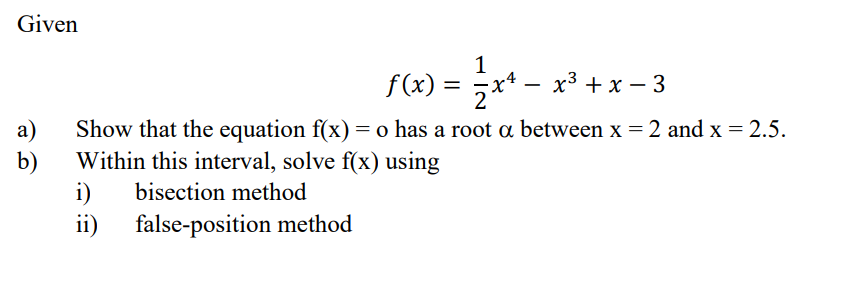Given \ \ f(x)=1/2x^4-x^3+x-3\ \ ... Show the equation?

1 Answer
a) The function
Now
Since
An interval like
b) (i) In the bisection method, we successively halve the interval, until it becomes sufficiently small to meet our accuracy goal. The steps for this particular function will go as follows :
-
Halve the interval at
(2+2.5)/2 = 2.25
qquad f(2.25)~~0.6738 > 0 ,
and thus the root is between 2 and 2.25 -
Bisect
[2,2.25] at2.125
qquad f(2.125) ~~ -0.2753 < 0 ,
and thus the root is between 2.125 and 2.25 -
Bisect
[2.125,2.25] at2.1875
qquad f(2.1875) ~~ 0.1688 > 0 ,
and thus the root is between 2.125 and 2.1875 -
Bisect
[2.125,2.1875] at 2.15625
qquad f(2.15625) ~~ -0.0605 < 0 ,
and thus the root is between 2.15625 and 2.1875
At this stage, we have narrowed down the root to within the interval
Note that though theoretically we may make the bracketing interval as small as we want, practical considerations (like the precision of the machine you are using tom calculate) may limit this to within reasonable values.
(ii) The problem with the bisection method is that it pays no attention to the values
In the false location method this replaces
-
c = (2f(2.5)-2.5f(2))/(f(2.5)-f(2)) ~~ 2.1135
qquad f(c) ~~ -0.3509<0
The new bracketing interval is [2.1135,2.5] -
For this interval,
c ~~ 2.1496
qquad f(c) ~~ -0.1076<0
The new bracketing interval is [2.1496,2.5] -
For this interval,
c ~~ 2.1603
qquad f(c) ~~ -0.0316<0
The new bracketing interval is [2.1603,2.5]
Note that unlike in the bisection method, where the bracketing interval is bound to become smaller by a factor of 2 on each step, for the false location method it is possible, as in this case,

